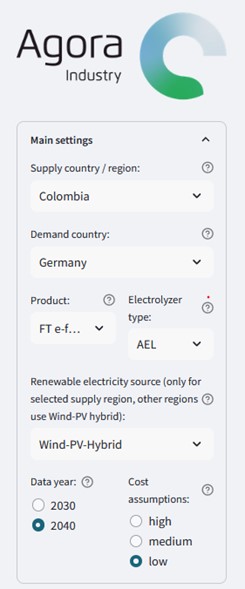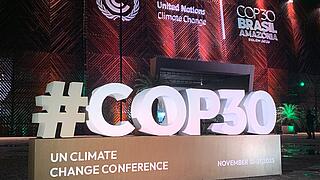Cost comparisons in international hydrogen trade: The PtX Business Opportunity Analyser (PtX-BOA)

Die Wirtschaftlichkeit von Wasserstoffimporten kalkulieren
© Öko-Institut
That proportion translates into demand for up to 90 terawatt-hours (TWh). Imports are expected to rise further post-2030. By 2045, Germany’s total hydrogen demand is anticipated to reach 360 to 500 TWh, to which a further 200 TWh in hydrogen derivatives will be added. Hydrogen and its derivatives will remain scarce and expensive commodities over a long timeframe. It follows that their deployment should only be planned where neither direct renewable energy use nor electrification are possible.
Diversifying import sources
Where should the hydrogen come from? To avoid the dependencies experienced in the past with natural gas, the German government’s hydrogen import strategy builds upon a broad variety of procurement sources. Within Europe, hydrogen could come via pipelines, for instance from Norway and Denmark in the north and Spain in the south. Beyond Europe, imports from North Africa, South America and the Middle East are planned – mainly in the form of derivatives. To this end, cooperative ventures with developing and newly industrialising countries are envisaged, not least because those countries can also benefit from the establishment of a green hydrogen economy. For this to succeed, all the sustainability dimensions of hydrogen will need to be taken into account, including, beside greenhouse gases, an array of further environmental, socio-economic and governance aspects. For instance, the question arises of local land-use rights that may be infringed by the land-use changes associated with a planned large-scale project. This is a question of major relevance in the countries of the Global South – as our metastudy on the sustainability dimensions of hydrogen conducted for the Amber Foundation has shown. Especially in the rural areas of such countries land rights are often informal, yet are a vital basis of local livelihoods.
Taking an external perspective
Future prices and the secure availability of hydrogen are currently hard to quantify. This is why the German federal government already established the H2Global Foundation in 2021 and based it on a double auction model. The Foundation’s purpose is to safeguard an ongoing hydrogen supply through long-term contracts with producer countries. The first auction for the purchase of green hydrogen and hydrogen derivatives started in late 2022. Fertiglobe – a nitrogen fertiliser producer and distributor based in the United Arab Emirates – won the auction by submitting the most favourably priced tender. The green ammonia is produced in Egypt, with imports to commence in 2027. Following import to the EU, batches of hydrogen are then to be auctioned onwards in a second auction. The import strategy thereby aims to provide investment security – among exporting countries and domestic industries in equal measure. The goal is that stakeholders and market players invest in the requisite infrastructure.
But how do possible producer countries shape up compared to each other? The Power-to-X Business Opportunity Analyser 2.0 (PtX-BOA) developed by the Oeko-Institut and Agora Industry now makes it possible to appraise cost-effectiveness from the perspective of potential supply countries and demand countries.
Appraising cost-effectiveness
First published in 2023, the calculation tool is now available in Version 2.0 as a web-based application. PtX-BOA currently covers most of the potential producer and demand countries worldwide, including deep-dive analysis with regional details for Argentina, Morocco and South Africa. Supply countries can appraise their prospects for a PtX value chain by using the tool to calculate the delivered cost of specific PtX products for specific demand-side markets. The tool differs from others in that it takes the perspective of the supply country. PtX-BOA thus helps to understand and appraise potential competitive advantages on global hydrogen markets. This information will also assist policymakers in understanding the specific PtX cost potential of their country and will thus facilitate the development of targeted policy actions to promote investment in the relevant value chains.
Using the tool: A sample calculation for Colombia

Input starts with the main settings to the left. Here the supply country and the demand country are selected. For the purposes of this demonstration, we select Colombia as supply country and Germany as demand country. Various products can be selected, including ammonia, green iron, hydrogen, LOHC (liquid organic hydrogen carriers), methane, methanol and electricity-derived fuels (Fischer-Tropsch (FT) e-fuels). The type of electrolysis can also be chosen: the commonplace low-temperature processes of alkaline water electrolysis (AEL) and proton exchange membrane electrolysis (PEM), and the high-temperature process of solid oxide electrolysis (SOEC).
Options for selection of the renewable energy source that is to be used for electricity generation include photovoltaics, offshore wind, onshore wind and hybrid facilities combining wind with photovoltaics.
To cover uncertainties and medium- and long-term developments, 2030 or 2040 can be selected as data years for PtX production. To reflect cost reduction pathways, the tool offers a choice among high-, medium- and low-cost scenarios.

Furthermore, a number of additional settings can be entered as required: Water is the second most important input to PtX production after electricity. Users can select whether the water is available via an own seawater desalination plant or is procured externally at a fixed specific price. Some PtX products require CO2 as a further input. The source for this can be selected as either an own direct air capture (DAC) plant or as external procurement at a fixed specific price.
If the tranportation distance is less than 6000 km pipelines can be used. If shipping is used, the fuel source can vary.
Finally, costs, which are always stated in US dollars, can be calculated in relation to energy content (USD per megawatt-hour) or product weight (USD per tonne).
After the settings have been selected, the analysis data are displayed in several tabs:

The Costs tab provides a map showing the delivered costs for the selected product and the selected demand country, for different producer countries. Moving the mouse over a marker brings up detailed information on costs:

Directly below, an overview of the cost distribution and individual cost components is provided:

The second tab, Market Scanning, contains information on modes of transport (pipeline or ship) in relation to the resulting costs and distances with regard to the various demand countries.
While BOA provides an analysis tool for Power-to-X, it cannot substitute local knowledge. It is therefore designed to be flexible enough to take account of local data such as capital costs of renewable energy sources, favourable loan terms and specific costs of sustainable CO2 sources, and to integrate these in the optimisation process.
The Country Fact Sheets tab provides more detailed information on all the producer and demand countries that can be selected in BOA. The demand country fact sheets contain country-specific information on the current demand for hydrogen, the national hydrogen and derivatives strategy, the characteristics of the country-specific hydrogen trade and the existing transport infrastructure. The fast sheets for potential producer countries provide information on the amount of hydrogen that can potentially be supplied, the existing LNG infrastructure, carbon capture and storage potential, electricity prices and information on whether a hydrogen strategy for the country is in place (and a link to any such document).
Is “green hydrogen” a viable proposition?
The tool focuses on the production and cost pathways of “green hydrogen” and derivatives. Producing green hydrogen will require green electricity which, however, is currently scarcely available or is not available at all in many developing and newly industrialising countries. Establishing hydrogen projects and infrastructures for export can have both positive and negative impacts on the often urgently needed expansion and climate-neutral reconfiguration of the domestic energy sector in a partner country. Germany’s national hydrogen strategy does not yet define specific criteria by which to assess the sustainability of projects on site. However, it does note explicitly that social standards are to be observed and that aspects such as sustainable water supply and land use are to be taken into account when pursuing hydrogen projects in developing and newly industrialising countries. The corresponding sustainability criteria will need to be formulated in a process of dialogue between producer and demand countries.
The Sustainability tab in PtX-BOA already gives users an overview of the relevant dimensions of sustainability with regard to hydrogen production, structured according to environmental, economic, social and governance aspects. A distinction is made between guardrails and goals. Guardrails can help to produce PtX products that are sustainable above and beyond their greenhouse gas emission intensity and do not have negative impacts in the producer country. Goals set higher standards, namely to shape PtX production in such a manner that the local environmental and socio-economic conditions in the producer country improve.

The PtX Hub project commissioned by Agora Energiewende and Agora Industry, which is due to run until mid-2025 and which has already generated the PtX Business Opportunity Analyser, is currently focused on extending the PtX calculation tool to cover the prospective greenhouse gas emissions that may be generated from diverse sources in the course of the production and supply of the various PtX products.
Dr Markus Haller works on instruments to promote the expansion of renewable energy as well as on system integration of renewable electricity and long-term scenarios of energy system transformation. Christoph Heinemann is an expert on the production and utilisation of hydrogen as an instrument of climate change mitigation. Dr Roman Mendelevitch is an expert on international energy resource markets. Susanne Krieger explores the sustainability dimensions of hydrogen production. All four scientists work in the Oeko-Institut’s Energy & Climate Division in Freiburg and Berlin.
Further information
PtX Business Opportunity Analyser
The German government's import strategy for hydrogen and hydrogen derivatives (as of July 2024)
The German government's official website on the national hydrogen strategy






